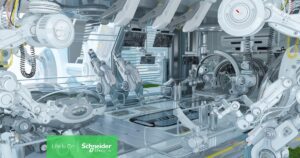Global market changes have forced manufacturers to rapidly adjust their factory systems to be more flexible and agile. Part of the operational reassessment involves developing an ability to accommodate more product variety, shorter resourcing of raw materials, faster production, and rapid delivery. These marketplace demands are driving the increased pace of digital transformation at many plant sites. The trend is often referred to as Industry 4.0, and it involves merging traditional OT or operations technologies with IT edge computing systems.
The manufacturing industry is rapidly deploying edge computing across a wide variety of use cases. According to Grand View Research, the edge computing market was valued at $7.43 billion USD in 2021, and it is expected to expand at a compound annual growth rate (CAGR) of 38.9% from 2022 through 2030.

Why the industrial edge is growing
The industrial edge is one of the fastest-growing segments of industrial automation. Examples of devices within industrial edge environments include sensors, programmable logic controllers (PLCs), and local machines with connectivity capabilities. To increase plant profitability, manufacturers must correctly measure asset performance, rapidly identify problem areas, and make crucial, real-time changes.
Data latency is one of the main issues driving manufacturers towards more edge computing. Many industrial applications require rapid response to assure product safety and quality. Computing power and storage are being placed at the industrial edge to lower data transport time and increase availability. Edge computing brings bandwidth-intensive and latency-sensitive applications closer to the user or data source.
Simplifying and standardizing industrial edge computing technology
A global network of technology partners acts as a provider of these industrial edge solutions. Although edge computing solutions tend to be small in size and footprint compared to traditional data centers, their function is often critical. Users who deploy edge systems face the challenges of not having IT resources on-site to support these systems. In addition, edge systems are often made up of multiple parts and pieces from multiple vendors, and configuring, delivering, and installing edge systems requires collaboration.
In such an environment, strong partnerships emerge as a critical success factor. No one company can do it alone. The task of properly managing multiple, local and remote edge systems can also be complex. This is why key OT technology providers like Schneider Electric partner with Dell Technologies, a global giant in IT server and storage solutions.
With deep networks of IT and OT partners across the globe, both Dell and Schneider Electric provide the programs and resources needed to simplify the configuration, delivery, installation, operation, and maintenance of edge computing systems.

Below are several examples of the Schneider Electric and Dell collaboration in the industrial edge space.
Micro data centers as solutions
Micro data centers are small, preassembled, pretested, and integrated solutions that are configured into an enclosure. The racks, servers, storage devices, power distribution units, uninterruptible power supplies (UPS), and management software can be made ready to operate before arriving at the end-user location. The core elements of the system all work together, so, end-users in edge environments, most of whom are unfamiliar with the workings of IT, have peace of mind knowing these systems can operate on their own, typically without any local support required. Additional security devices, such as racks with card key access and server room security cameras, can also be easily added to the micro data center configuration.
When Schneider Electric’s EcoStruxure ™ Micro Data Centers are matched with Dell Technologies ruggedized VxRail P-Series High Performance Servers, end users gain access to an integrated solution that is both reliable and remotely manageable.
Reference designs for rapid deployment
Reference designs are a series of tested, validated, and documented plans for assembling and laying out specific physical infrastructure components (racks, power, cooling, security) aligned to common customer environments. They can be refined to meet particular needs and provide 90% of what is needed to help expedite the delivery of the edge computing project. Schneider Electric has jointly developed specific reference designs for industrial edge environments, including the Dell IT components. Reference design libraries are used to select an integrated solution. Those designs are then refined to accommodate the unique requirements of the particular factory OT edge environment.
Reference designs provide benefits to both end users and partners in several ways:
- Reduced engineering time – Pretested and validated design reduces trial and error of matching up compatible components.
- Rapid deployment speed – Preassembled units mean ready-to-go solutions are available for operation upon delivery without delays from waiting for missing components.
- Lower risk of human error – Fewer people are required for systems installation and setup and built-in physical security greatly reduce the possibility of unanticipated errors.
- Higher sustainability – Micro data center solutions only require one shipment rather than the shipping of multiple separate parts and pieces. This has a positive impact on reducing Scope 3 emissions.
Networks of Managed Service Providers (MSPs) for support
Dell and Schneider Electric channel partners are expanding their business models to offer remote edge computing support services. This helps end-users by providing them with a vast network of edge computing experts for management, technical support, and predictive maintenance services. In addition, these MSPs support end-users by remotely managing edge sites to ensure high system availability, energy savings, and predictable system performance.
Based on the individual end user’s business requirements, the power of this partner ecosystem works to manage and simplify the client/vendor interface as much as possible. The success of the partnership ecosystem not only depends on enlisting organizations with different micro data center and edge computing competencies, but also can include partners who are experts within specific geographic regions to accommodate customers with an extended global presence. Enterprise organizations want to experience consistent support for edge IT (computing, network, and storage) and OT (power, cooling, environmental monitoring, and security) assets across all geographies. Combined, these partnerships give end users peace of mind knowing that project deployment risks are minimized.
Practical solutions for the industrial edge
Download the reference design to learn more about Schneider Electric and Dell’s micro data center, particularly for industrial edge applications. Also, discover what Schneider Electric’s and Dell’s alliance can do for your organization.


